8DProblem Solving Process
- 格式:pptx
- 大小:520.85 KB
- 文档页数:67
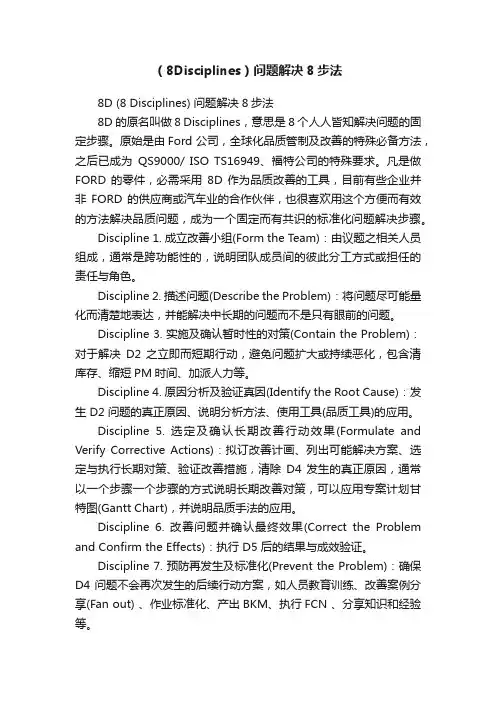
(8Disciplines)问题解决8步法8D (8 Disciplines) 问题解决8步法8D的原名叫做 8 Disciplines,意思是8 个人人皆知解决问题的固定步骤。
原始是由Ford 公司,全球化品质管制及改善的特殊必备方法,之后已成为QS9000/ ISO TS16949、福特公司的特殊要求。
凡是做FORD 的零件,必需采用8D 作为品质改善的工具,目前有些企业并非FORD 的供应商或汽车业的合作伙伴,也很喜欢用这个方便而有效的方法解决品质问题,成为一个固定而有共识的标准化问题解决步骤。
Discipline 1. 成立改善小组(Form the Team):由议题之相关人员组成,通常是跨功能性的,说明团队成员间的彼此分工方式或担任的责任与角色。
Discipline 2. 描述问题(Describe the Problem):将问题尽可能量化而清楚地表达,并能解决中长期的问题而不是只有眼前的问题。
Discipline 3. 实施及确认暂时性的对策(Contain the Problem):对于解决D2 之立即而短期行动,避免问题扩大或持续恶化,包含清库存、缩短PM时间、加派人力等。
Discipline 4. 原因分析及验证真因(Identify the Root Cause):发生 D2 问题的真正原因、说明分析方法、使用工具(品质工具)的应用。
Discipline 5. 选定及确认长期改善行动效果(Formulate and Verify Corrective Actions):拟订改善计画、列出可能解决方案、选定与执行长期对策、验证改善措施,清除D4 发生的真正原因,通常以一个步骤一个步骤的方式说明长期改善对策,可以应用专案计划甘特图(Gantt Chart),并说明品质手法的应用。
Discipline 6. 改善问题并确认最终效果(Correct the Problem and Confirm the Effects):执行 D5 后的结果与成效验证。
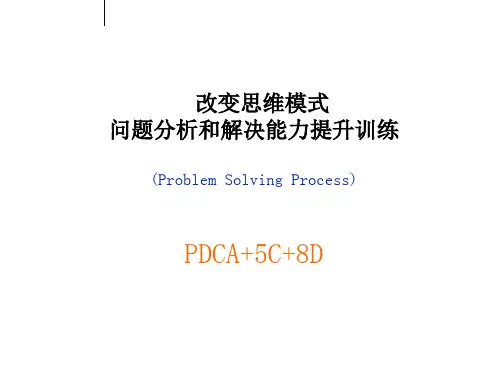
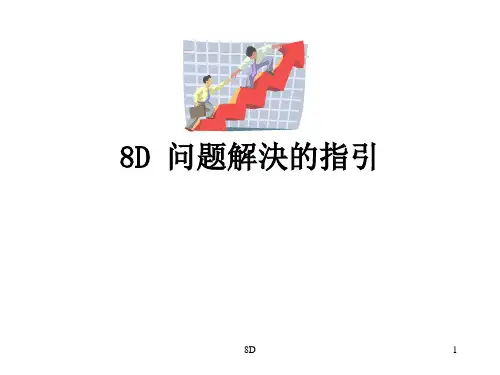
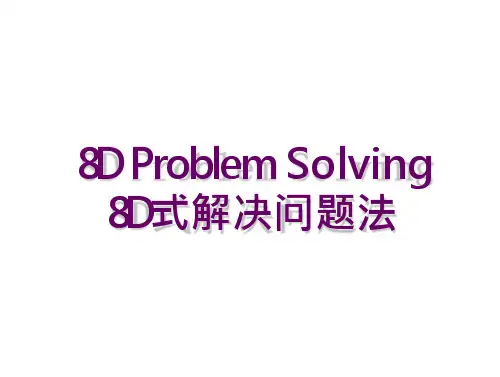
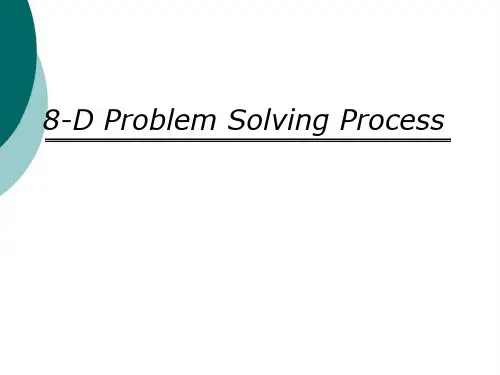
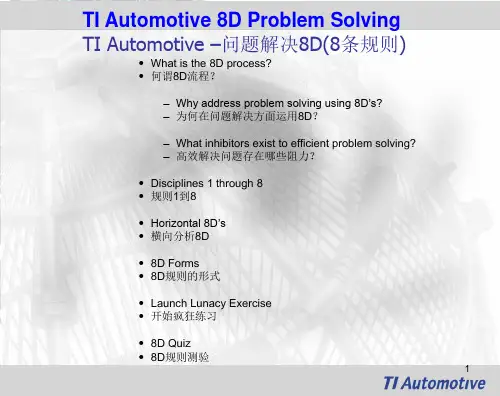
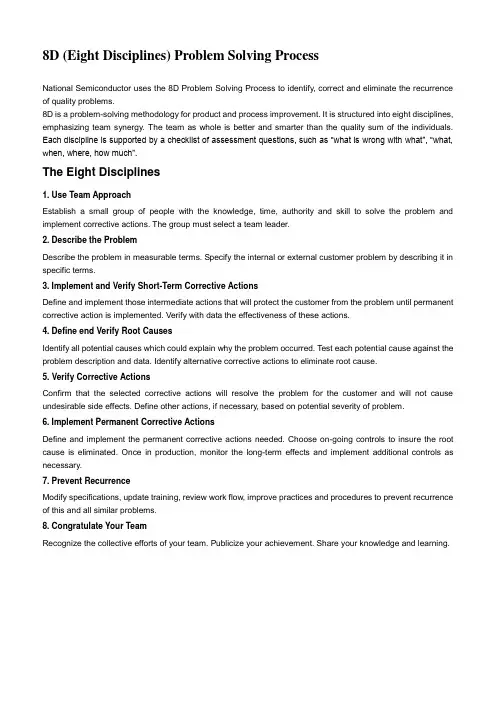
8D (Eight Disciplines) Problem Solving ProcessNational Semiconductor uses the 8D Problem Solving Process to identify, correct and eliminate the recurrence of quality problems.8D is a problem-solving methodology for product and process improvement. It is structured into eight disciplines, emphasizing team synergy. The team as whole is better and smarter than the quality sum of the individuals. Each discipline is supported by a checklist of assessment questions, such as “what is wrong with what”, “what, w hen, where, how much”.The Eight Disciplines1. Use Team ApproachEstablish a small group of people with the knowledge, time, authority and skill to solve the problem and implement corrective actions. The group must select a team leader.2. Describe the ProblemDescribe the problem in measurable terms. Specify the internal or external customer problem by describing it in specific terms.3. Implement and V erify Short-Term Corrective ActionsDefine and implement those intermediate actions that will protect the customer from the problem until permanent corrective action is implemented. Verify with data the effectiveness of these actions.4. Define end V erify Root Cause sIdentify all potential causes which could explain why the problem occurred. T est each potent ial cause against the problem description and data. Identify alternative corrective actions to eliminate root cause.5. Verify Corrective ActionsConfirm that the selected corrective actions will resolve the problem for the customer and will not cause undesirable side effects. Define other actions, if necessary, based on potential severity of problem.6. Implement Permanent Corrective ActionsDefine and implement the permanent corrective actions needed. Choose on-going controls to insure the root cause is eliminated. Once in production, monitor the long-term effects and implement additional controls as necessary.7. Prevent RecurrenceModify specifications, update training, review work flow, improve practices and procedures to prevent recurrence of this and all similar problems.8. Congratulate Y our TeamRecognize the collective efforts of your team. Publicize your achievement. Share your knowledge and learning.8D Problem Solving Process FlowchartCustomer Complaint Corrective & Preventive Action Report (8D)FILE NO.: T-DSL-02-001B2 -------------------------------------- CAR NO: CAR-030411-E-------------------- CO MAX TECHNOLOGY CO., LTD.Corrective & Preventive Action Report (8D)1、Form the TeamDate Started:Sep. 22, 2002Internal team member:A, B, CExternal team member:N/A2. Describe the ProblemOne field failed unit of XXX model was returned from the customer on Sep. 20. The failure occurred at the end-user‟s site with the symptom described as …The unit burned when powered on with line and could not be powered on again.‟3. Describe the Root Cause3.1 What FoundAfter carefully investigation it is found that components listed below in the XXX circuit are damaged:Part Spec. DescriptionD5,D6,D7,D8 XX A/XX V Rectifier Diode3.2 Circuit Schematic3.3 Fishbone Diagram3.4 Experiments to Reproduce the Failure3.4.1 D5-D8 temperature measurementCondition: 1) The unit operates at ambient temperature; 2) Connecting a xx Ohm resistor between positive and negative terminals of the battery to stimulate very low battery voltage.Result:Case temperature of the diodes stabilizes at about 60 degree Celsius which is much lower than the maximum rating with adequate margin.3.4.2 Battery short circuitCondition: Short circuit the battery and measure the current passes through D5-D8 with current probe. Result: The current is zero3.4.3 Low battery voltageThe unit operates with the DC power provided by a xx V(which is much lower than the nominal xx V) battery. Measure the current passes through D5-D8 and no over-current is found.3.4.4 Over-current through D5-D8 when power on with nominal I/P AC voltageThe DC power is provided by a battery with nominal voltage. Measure the current passes through D5-D8 with current probe at the moment when power on the unit with nominal AC input voltage. Over-current is found.3.4.5 High input AC voltage and low battery voltage when power onConnect a xx Ohm resistor between positive and negative terminals of the battery to stimulate very l ow battery voltage. Measure the current passes through D5-D8 with current probe at the moment when power on the unit with xx AC. The current reaches xx A which is much larger than the maximum rating xx A and that can easily destroy the diodes.3.5 ConclusionBased on the above experiments, the root cause is that at the moment when power on the unit, especially with low battery voltage and high input AC voltage, out-of-spec current through the diodes presents.4. Containment PlanFix the unit, replace damaged components5. Permanent C/A Plan5.1 Change Cxx from xx μF/xx V electrolytic capacitor to xx uF/xx V X-Cap to reduce the current through therectifier when power on the unit.5.2 Use an integrated rectifier to replace D5-D8.5.3 RD release ECR for customer approval of the above engineering changes after the effectiveness is verified.5.4 RD release ECN to validate the changes after the ECR is approved.6. Verify the effectiveness of C/A6.1 Measure the current through the integrated rectifier at the same condition of 2.4.5, no over-current is found.6.2 Perform power cycling on 10 engineering changed units under the condition described at 2.4.5 for 48 hours,no failure was found.7、Prevent Recurrence8、Congratulate the TeamThe ECR has been sent to XXX (the customer name) for approval on Sep. 25. and the updated procedure will be released formally by DCC immediately when receive the approval. Thanks for the excellent work of the team. Date Closed: Sep. 26, 2002。
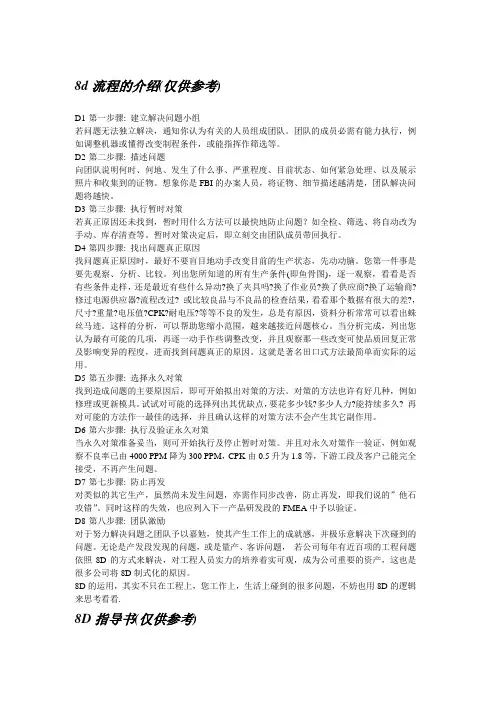
8d流程的介绍(仅供参考)D1-第一步骤: 建立解决问题小组若问题无法独立解决,通知你认为有关的人员组成团队。
团队的成员必需有能力执行,例如调整机器或懂得改变制程条件,或能指挥作筛选等。
D2-第二步骤: 描述问题向团队说明何时、何地、发生了什么事、严重程度、目前状态、如何紧急处理、以及展示照片和收集到的证物。
想象你是FBI的办案人员,将证物、细节描述越清楚,团队解决问题将越快。
D3-第三步骤: 执行暂时对策若真正原因还未找到,暂时用什么方法可以最快地防止问题?如全检、筛选、将自动改为手动、库存清查等。
暂时对策决定后,即立刻交由团队成员带回执行。
D4-第四步骤: 找出问题真正原因找问题真正原因时,最好不要盲目地动手改变目前的生产状态,先动动脑。
您第一件事是要先观察、分析、比较。
列出您所知道的所有生产条件(即鱼骨图),逐一观察,看看是否有些条件走样,还是最近有些什么异动?换了夹具吗?换了作业员?换了供应商?换了运输商?修过电源供应器?流程改过? 或比较良品与不良品的检查结果,看看那个数据有很大的差?,尺寸?重量?电压值?CPK?耐电压?等等不良的发生,总是有原因,资料分析常常可以看出蛛丝马迹。
这样的分析,可以帮助您缩小范围,越来越接近问题核心。
当分析完成,列出您认为最有可能的几项,再逐一动手作些调整改变,并且观察那一些改变可使品质回复正常及影响变异的程度,进而找到问题真正的原因。
这就是著名田口式方法最简单而实际的运用。
D5-第五步骤: 选择永久对策找到造成问题的主要原因后,即可开始拟出对策的方法。
对策的方法也许有好几种,例如修理或更新模具。
试试对可能的选择列出其优缺点,要花多少钱?多少人力?能持续多久? 再对可能的方法作一最佳的选择,并且确认这样的对策方法不会产生其它副作用。
D6-第六步骤: 执行及验证永久对策当永久对策准备妥当,则可开始执行及停止暂时对策。
并且对永久对策作一验证,例如观察不良率已由4000 PPM降为300 PPM,CPK由0.5升为1.8等,下游工段及客户己能完全接受,不再产生问题。
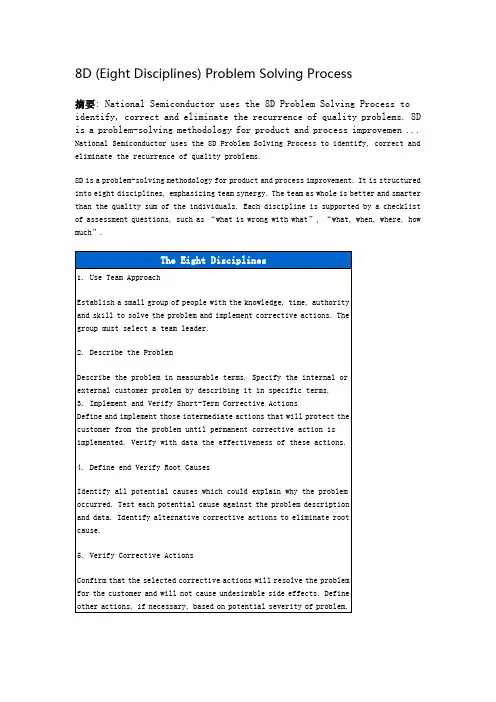
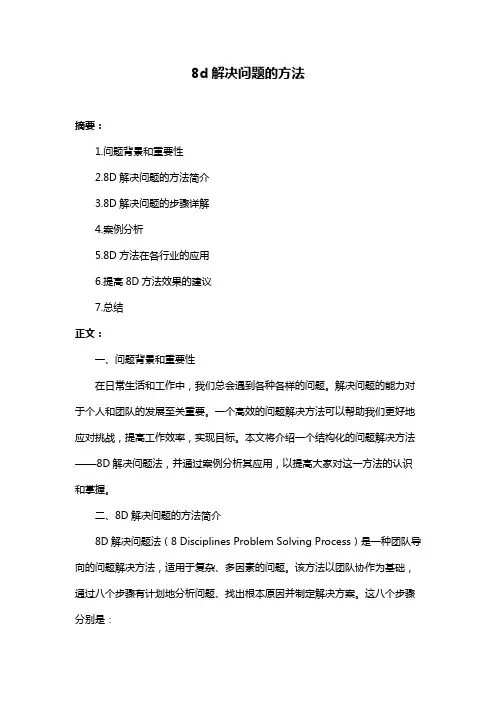
8d解决问题的方法摘要:1.问题背景和重要性2.8D解决问题的方法简介3.8D解决问题的步骤详解4.案例分析5.8D方法在各行业的应用6.提高8D方法效果的建议7.总结正文:一、问题背景和重要性在日常生活和工作中,我们总会遇到各种各样的问题。
解决问题的能力对于个人和团队的发展至关重要。
一个高效的问题解决方法可以帮助我们更好地应对挑战,提高工作效率,实现目标。
本文将介绍一个结构化的问题解决方法——8D解决问题法,并通过案例分析其应用,以提高大家对这一方法的认识和掌握。
二、8D解决问题的方法简介8D解决问题法(8 Disciplines Problem Solving Process)是一种团队导向的问题解决方法,适用于复杂、多因素的问题。
该方法以团队协作为基础,通过八个步骤有计划地分析问题、找出根本原因并制定解决方案。
这八个步骤分别是:1.组成团队2.确定问题3.制定计划4.收集数据5.分析数据6.确定根本原因7.制定解决方案8.实施并验证解决方案三、8D解决问题的步骤详解1.组成团队:一个跨职能的团队,包括涉及问题领域的专家和相关部门的代表。
团队成员应具备解决问题所需的技能和知识,人数一般在5-10人之间。
2.确定问题:明确问题的定义,描述问题的现象和影响,确保团队成员对问题有共识。
可以使用鱼骨图、流程图等工具辅助分析问题。
3.制定计划:确定解决问题的目标和期限,制定详细的工作计划,包括每个步骤的时间安排和资源分配。
4.收集数据:通过现场观察、访谈、问卷调查等方式收集与问题相关的数据。
数据应具有客观性、完整性和准确性,以便后续分析。
5.分析数据:对收集的数据进行整理和分析,找出数据的规律和趋势。
可以使用多种分析工具,如帕累托图、相关性分析等。
6.确定根本原因:根据数据分析结果,找出导致问题的根本原因。
可以使用因果图、头脑风暴等方法,充分挖掘问题的深层次原因。
7.制定解决方案:针对根本原因,制定具体的解决方案。
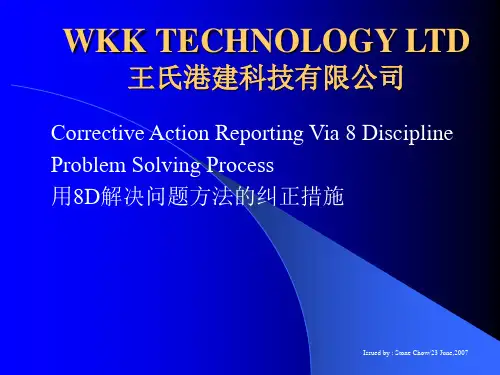
Problem solving process (8-D method)问题解决过程 (8-D方法)“8D”是一种通过8个步骤解决问题的方法。
“8D” 是通过以下三个途径解决问题并防止问题(投诉)的重复发生:●快速地,持久地,系统地处理内外部的投诉,分析定位并消除根本原因。
●把经验教训应用到相似的过程及产品上。
●制定并不断完善解决问题过程的文档。
D1: Problem solving team问题解决小组:成立的解决小组成员需要对产品和过程比较熟悉并且有经验,且至少包含技术,质量和生产部门。
D2: Problem description 问题描述:问题描述是指详细的描述出不良现象、问题零件以及出现什么样的影响。
描述必须清楚易懂,如果有必要,可以提供一些样品(例如不良零件,图片,图纸等)进一步说明不良现象,以便于简单化分析。
D3:Containment actions围堵措施:一旦发现不良,即时遏制措施必须实行,以保护客户的不接收,不使用或不生产不合格产品。
因此,遏制行动,仅仅是一种保护措施,往往与问题的原因是没有关系的。
例如:挑选,返工,报废,等围堵措施都是与问题的原因没有关系。
D4:Root cause analysis根本原因分析●根本原因分析应确定:为什么发生了不合格和为什么不合格产品没有被探测到●必须对受影响的产品及其加工过程进行调查和因果关系分析(哪一个组件/产品导致不良,哪一个过程导致不良)●所有导致不良的可能情况必须都要被考虑●必须由适当的方法和工具来支持这种分析(如QC七大手法, FMEA ,鱼骨图, 5why)●评估与问题相关的潜在风险(不良品所影响的时间和数量)。
●D5:Corrective actions and proof of effectiveness改善措施和验证有效性:●根据D4定义可能的改善措施来消除根本的不良。
●所有能解决和最终消除问题的方法必须可实施的,可评估的。